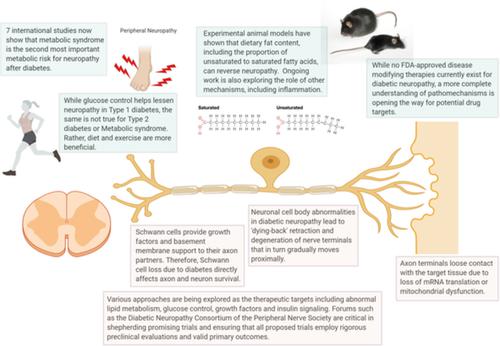当前位置:
X-MOL 学术
›
J. Peripher. Nerv. Syst.
›
论文详情
Our official English website, www.x-mol.net, welcomes your
feedback! (Note: you will need to create a separate account there.)
Diabetic polyneuropathy: Bridging the translational gap.
Journal of the Peripheral Nervous System ( IF 3.9 ) Pub Date : 2020-06-23 , DOI: 10.1111/jns.12392 Masaki Kobayashi 1, 2 , Douglas W Zochodne 3
Journal of the Peripheral Nervous System ( IF 3.9 ) Pub Date : 2020-06-23 , DOI: 10.1111/jns.12392 Masaki Kobayashi 1, 2 , Douglas W Zochodne 3
Affiliation

|
Clinical trials for diabetic polyneuropathy (DPN) have failed to identify therapeutic impacts that have arrested or reversed the disorder, despite a long history. This review considers DPN in the context of a unique neurodegenerative disorder that targets peripheral neurons and their companion glial cells. The approach is to examine what cells, cell substructures, and pathways are implicated in causing DPN and how they might be addressed therapeutically. These include axonopathy, neuronopathy, hyperglycemia, polyol flux, advanced glycation endproduct (AGE)‐receptor AGE signaling, growth factor disruption, abnormal insulin signaling, and abnormalities of other intrinsic neuron pathways. Mitochondrial dysfunction and lipid toxicity are largely delegated to the companion review in this issue by Stino and Feldman. Finally, the linkage between axon plasticity of cutaneous nerves, peripheral neuroregenerative pathways, and diabetes are discussed.
中文翻译:

糖尿病性多发性神经病:弥合翻译间隙。
尽管已有悠久的历史,但糖尿病多发性神经病(DPN)的临床试验未能发现可阻止或逆转该疾病的治疗作用。这项审查认为DPN在针对周围神经元及其伴随的神经胶质细胞的独特神经退行性疾病的背景下。该方法是检查导致DPN的原因涉及哪些细胞,细胞亚结构和途径,以及如何进行治疗。这些包括轴突病,神经病,高血糖症,多元醇通量,晚期糖基化终产物(AGE)-受体AGE信号传导,生长因子破坏,胰岛素信号异常以及其他内在神经元途径异常。线粒体功能障碍和脂质毒性在很大程度上由Stino和Feldman撰写。最后,
更新日期:2020-06-23
中文翻译:

糖尿病性多发性神经病:弥合翻译间隙。
尽管已有悠久的历史,但糖尿病多发性神经病(DPN)的临床试验未能发现可阻止或逆转该疾病的治疗作用。这项审查认为DPN在针对周围神经元及其伴随的神经胶质细胞的独特神经退行性疾病的背景下。该方法是检查导致DPN的原因涉及哪些细胞,细胞亚结构和途径,以及如何进行治疗。这些包括轴突病,神经病,高血糖症,多元醇通量,晚期糖基化终产物(AGE)-受体AGE信号传导,生长因子破坏,胰岛素信号异常以及其他内在神经元途径异常。线粒体功能障碍和脂质毒性在很大程度上由Stino和Feldman撰写。最后,











































 京公网安备 11010802027423号
京公网安备 11010802027423号